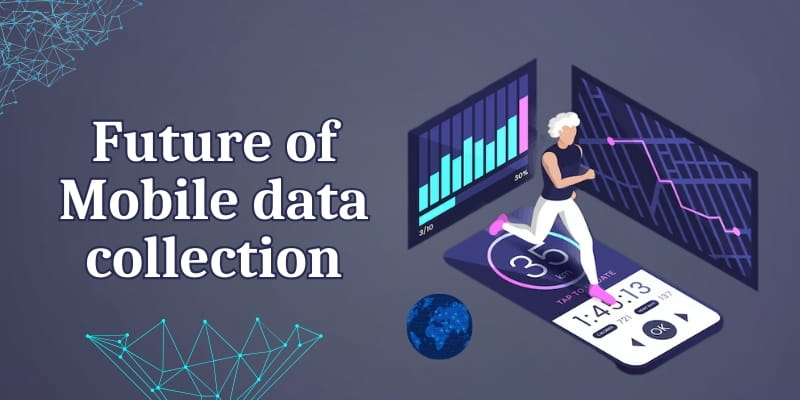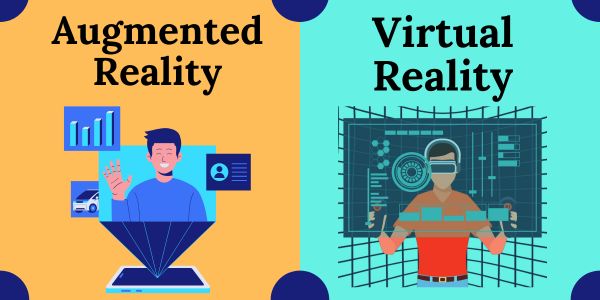The Future of Mobile Data Collection – Top Trends
Digital data collection has revolutionized how businesses and organizations collect and analyze data, making it easier to collect and process huge packets of data from anywhere at any time.
As technology advances rapidly, mobile data collection is also evolving, with new trends and technologies emerging that are reshaping the future of data collection.
From IoT devices to artificial intelligence, augmented reality, blockchain, cloud computing, and mobile-first design, these emerging trends and technologies are poised to transform how businesses collect, store, and analyze data, providing valuable insights and improving the accuracy and efficiency of data collection.

So, this article will talk about the latest trends and predictions in digital data collection and discuss how businesses can leverage these technologies to stay competitive.
What Is Mobile Data Collection?
Mobile data collection means using mobile devices like smartphones, tablets, or IoT gadgets to collect information.
This data can come from surveys, customer feedback, sensors, or even wearable devices. Mobile data collection is important because it allows companies to gather real-time information from any location.
Why Is Mobile Data Collection Important?
Here are some of the reasons that show you why the mobile data collection is essential:
- Faster Data Gathering: Mobile tools make it possible to collect data instantly.
- Improved Accuracy: Automated tools reduce errors in data collection.
- Cost-Effective: Using mobile devices reduces the need for expensive hardware and manual labor.
- Real-Time Insights: Companies can act quickly based on the data they collect.
Trends in Mobile Data Collection
So, guys, here we will discuss the latest trends and predictions in mobile data collection in detail.
- Internet of Things (IoT) Devices
- Artificial Intelligence (AI) and Machine Learning (ML)
- Augmented Reality (AR) and Virtual Reality (VR)
- Blockchain
- Cloud Computing
- Natural Language Processing (NLP)
- Mobile-First Design
- Edge Computing
- Big Data Analytics
- Wearable Technology
- 5G Technology
- Social Media Monitoring
- Biometric Data Collection
- Gamification
- Voice Assistants
- Remote Sensing
Let us learn about each in detail.
1. Internet of Things (IoT) Devices
IoT devices are smart gadgets, like fitness trackers or weather sensors, that collect and share information on their own. They help us learn important things quickly and accurately.
- Real-Time Data Collection: These devices can collect and share information immediately. For example, a smartwatch tracks your heartbeats and sends the data to your phone.
- Reduces Human Work: IoT devices collect information automatically, so people don’t need to do the work manually.
- High Accuracy: The data collected by IoT devices is often more accurate because it reduces human error.
- Useful for Businesses: Businesses use IoT devices to monitor things like factory machines, farming conditions, or even customer behaviors in stores.
2. Artificial Intelligence (AI) and Machine Learning (ML)
AI and ML are like really smart robots that can understand data and make predictions. They help people and businesses by spotting patterns in the data that humans might miss. AI-powered solutions, like Best Characters AI, are revolutionizing how businesses understand and process data. AI can analyze patterns, predict customer preferences, and improve decision-making.
- Understand Customer Behavior: AI can study what people buy online and suggest things they might like.
- Predict Future Trends: ML uses past data to guess what might happen next, like predicting the weather or traffic.
- Save Time and Effort: By automating tasks, AI and ML let people focus on other important work.
- Make Better Decisions: Businesses can use AI tools to analyze data and decide what steps to take next.
3. Augmented Reality (AR) and Virtual Reality (VR)
AR and VR technologies are used to make you feel like you are in a different world or add digital things to the real world. They are fun and also useful for collecting data.

- AR Adds Digital Information: Imagine pointing your phone at a museum painting and seeing extra details about it on the screen. That’s AR collecting data for you!
- VR Simulates Environments: VR can create fake places where people can test things safely, like learning to drive a car.
- Interactive and Engaging: These technologies collect data while giving users a fun, immersive experience.
- Safe and Controlled Testing: Businesses use VR to gather data in environments where it’s hard or dangerous to do in real life, like testing airplane designs.
4. Blockchain
Blockchain is a special system for keeping data safe and untampered. It’s like a digital notebook where no one can change what’s written without everyone agreeing.
- Secure and Transparent: Data stored in blockchain cannot be altered, ensuring it stays trustworthy.
- Prevents Hacking: It’s very hard for hackers to change the data in a blockchain system.
- Great for Privacy: Sensitive information like medical records or payments can be securely stored.
- Trusted by Businesses: Many companies use blockchain to make sure their collected data is reliable.
5. Cloud Computing
Cloud computing is like a giant online storage box where businesses keep their data. It helps them access and analyze information from anywhere in the world.
- Access Data Anytime: Businesses can log in and see their data, whether they are at the office or home.
- Save Money: Cloud storage costs less than buying and maintaining physical storage devices.
- Fast and Scalable: Companies can easily increase their storage space as they collect more data.
- Secure and Reliable: Cloud companies ensure the data is protected with strong security.
6. Natural Language Processing (NLP)
NLP is a type of AI that helps computers understand human language. It’s used to read and analyze things like social media posts or emails.
- Understand Customer Feelings: NLP can analyze reviews or comments to see if people are happy or upset.
- Find Trends: Businesses can spot what’s popular or what people are talking about the most.
- Real-Time Feedback: NLP tools can process customer feedback instantly, helping businesses respond quickly.
- Automate Conversations: Chatbots use NLP to answer customer questions online.
7. Mobile-First Design
Mobile-first design means making apps and websites easy to use on smartphones and tablets. Since most people use their phones for the internet, this is very important.
- Easy to Use: Apps are designed to fit small screens, making them simple to navigate.
- Fast Loading: Websites load quickly on phones, so users don’t get frustrated.
- More People Reachable: Businesses can connect with more customers since almost everyone has a phone.
- Better User Experience: Mobile-first design ensures users have a smooth and enjoyable time online.
8. Edge Computing
Edge computing brings data processing closer to where the data is collected, like on a local device instead of a distant server. It helps make things faster and smoother. There are many advantages of mobile phone in the market.

This can be specifically important in remote or low-bandwidth environments where traditional cloud-based solutions may not be feasible.
- Faster Data Processing: Information is processed near its source, reducing delays.
- Works in Remote Areas: It’s useful in places with slow internet connections, like rural farms.
- Saves Bandwidth: Since less data is sent to faraway servers, it uses less internet.
- Improves Efficiency: Edge computing makes things like self-driving cars or smart home devices more responsive.
9. Big Data Analytics
Big data analytics means analyzing huge amounts of information to find useful patterns and trends. It helps businesses make better choices and plan for the future.
- Find Patterns: Computers can spot trends in data that humans might miss.
- Make Predictions: Businesses use past data to guess what might happen next.
- Better Plans: Big data helps companies create smarter strategies.
10. Wearable Technology
Wearables like fitness trackers and smartwatches are not just cool gadgets; they collect important data about our daily activities and health.
- Track Health: Monitor your steps, heartbeats, and sleep patterns easily.
- Personalized Tips: Devices offer advice based on the data they collect.
- Safer Workplaces: Wearables help keep workers safe in risky jobs like construction.
11. 5G Technology
5G is the next generation of super-fast internet that allows more devices to connect and work smoothly.
- Quick Data Sharing: Send and receive data instantly without waiting.
- More Devices Connected: 5G supports many gadgets working together.
- Clearer Videos: Stream high-quality videos with no buffering.
12. Social Media Monitoring
Social media platforms like Instagram, Facebook, and Twitter are goldmines for businesses to understand their audience.
- See Popular Trends: Find out what people are talking about and what’s trending.
- Get Feedback: Companies learn what customers like or dislike about their products.
- Reach More People: Social media helps businesses connect with larger audiences.
13. Biometric Data Collection
Biometric tools use unique physical features like your fingerprint, voice, or face to gather data securely and efficiently.
- Enhance Security: Use your face or fingerprint to unlock devices or apps.
- Speed Up Access: No need to type passwords anymore.
- Safer Payments: Approve transactions using your unique biometric data.
14. Gamification
Gamification adds fun to data collection by turning surveys or activities into games. It encourages more people to participate.
- Interactive Surveys: Answer questions in a playful way.
- Better Participation: People enjoy sharing information through games.
- Attract Young Users: Kids and teenagers love engaging with gamified tools.
15. Voice Assistants
Voice assistants like Alexa, Siri, and Google Assistant make life easier by collecting data through spoken commands.
- Hands-Free Help: Control devices or get answers using your voice.
- Personalized Answers: Receive suggestions based on your preferences.
- Smart Homes: Manage your home devices like lights or thermostats with voice commands.
16. Remote Sensing
Remote sensing uses drones, satellites, or other devices to collect data from faraway or difficult-to-reach places.
- Monitor Nature: Keep an eye on forests, rivers, and weather conditions.
- Help in Emergencies: Quickly track storms, floods, or fires.
- Support Farmers: Check soil health and crop growth to improve farming.
Final Note
Digital data collection is changing quickly. Businesses that adopt the latest technologies will benefit the most.
- Stay Updated: Always look for new tools and trends.
- Improve Processes: Use these technologies to make data collection faster and more accurate.
- Stay Competitive: Businesses that adapt will lead in their industries.
By using these tools, companies can collect, store, and analyze data in ways that were never possible before. The future of mobile data collection is bright, and those who embrace it will see great success.




Please Write Your Comments